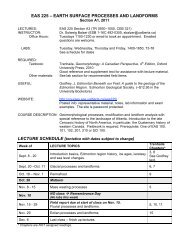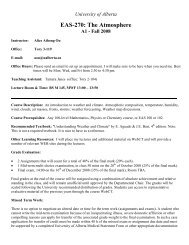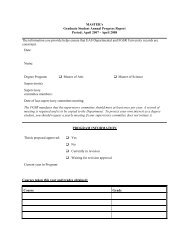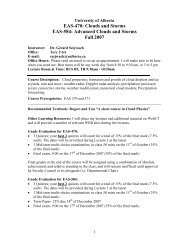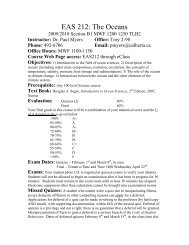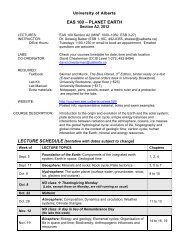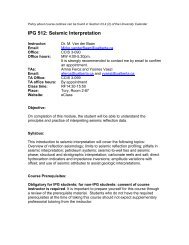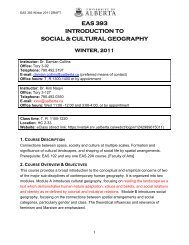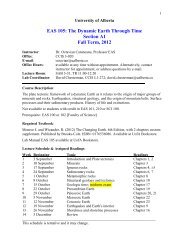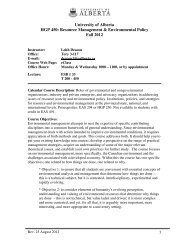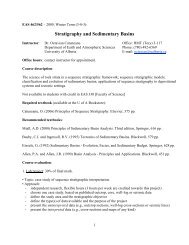Syllabus EAS 593: Human Dimensions of Global Change ...
Syllabus EAS 593: Human Dimensions of Global Change ...
Syllabus EAS 593: Human Dimensions of Global Change ...
Create successful ePaper yourself
Turn your PDF publications into a flip-book with our unique Google optimized e-Paper software.
<strong>Syllabus</strong><strong>EAS</strong> <strong>593</strong>: <strong>Human</strong> <strong>Dimensions</strong> <strong>of</strong> <strong>Global</strong> <strong>Change</strong>Department <strong>of</strong> Earth and Atmospheric SciencesUniversity <strong>of</strong> AlbertaTime: Fridays, 1:00-3:50Dates: January 11- April 11Instructor: Dr. Lia Ruttanlmruttan@shaw.caOffice Hours:Course DescriptionThis course reviews historical and current factors that influence the human dimensions <strong>of</strong>global change. Emphasized are changes occurring as a result <strong>of</strong> human use <strong>of</strong> resourcesand the consequent impacts on local and global environments. The course looks at issues<strong>of</strong> environmental governance and uses a framework <strong>of</strong> linked social and ecologicaldynamics to review the role <strong>of</strong> social institutions in modifying, regulating and/orenhancing environmental interaction at a variety <strong>of</strong> scales. The interaction <strong>of</strong> resource,technological, socio-cultural, political, and economic factors within environment will beexplored and theoretical models critiqued. Alternative frameworks for assessing,mitigating, and adapting to global environmental change are reviewed. The course willrely on a mixture <strong>of</strong> lectures, discussion, guest speakers, case study, and student presentation.Course objectivesStudents will:1. Be introduced to the history <strong>of</strong> and current status <strong>of</strong> a range <strong>of</strong> biophysical,anthropogenic, economic and sociopolitical factors as they affect worldenvironment.2. Be introduced to how philosophical views and assumptions common in Westernsociety have affected our responses and views regarding these changes.3. Develop an understanding <strong>of</strong> how issues <strong>of</strong> environmental governance affectinstitutional change in natural resource contexts including the exploration <strong>of</strong>common pool resource norms, innovation, institutional change and socio-politicalfactors.4. Develop an understanding <strong>of</strong> the how institutions, technology, resources andculture interact to produce patterns <strong>of</strong> response in regards to thehuman dimensions <strong>of</strong> global change.
5. Explore processes associated with assessing linked social and ecological changeincluding adaptation, adaptive management, resilience, and vulnerability in thecontext <strong>of</strong> response.6. Be introduced to how ethical factors, risk, and equity may affect the distribution<strong>of</strong> the impacts <strong>of</strong> global change.7. Have an opportunity to explore a more specific issue through the completion <strong>of</strong> amajor research paper.8. Explore the theoretical and methodological approaches presented in the course inlight <strong>of</strong> a particular case study – that <strong>of</strong> industrial development in northernAlbertaGrading: Take home Midterm 30%Paper 35%Presentation (on paper topic) 10%Case study response 10%Participation 10%Brief assignment 05%Graduate students enrolled in <strong>EAS</strong> <strong>593</strong> will attend and participate in the same classsessions as the fourth year students enrolled in <strong>EAS</strong> 493. Graduate students will meetwith the instructor to discuss additional expectations. They will include a longer andmore in-depth paper, preparation for leading a discussion <strong>of</strong> one <strong>of</strong> the assigned readingsfor the class, and a more extensive presentation on their research paper. Grading willreflect their graduate status.Note: Final grades at the end <strong>of</strong> the course will be assigned using a combination <strong>of</strong> absoluteachievement and relative standing in the course and will remain un<strong>of</strong>ficial until approved bythe Faculty Council or its designate (i.e. the Departmental Chair).Students with Special NeedsSpecialized Support and Disability Services (SSDS) provides assistance to Universitystudents whose disabilities involve any number <strong>of</strong> conditions affecting mobility, vision,hearing, learning or mental or physical health. Students who require accommodations inthis course due to a disability affecting mobility, vision, hearing, learning, or mental orphysical health are encouraged to discuss their needs with Specialized Support andDisability Services (2-800 Students' Union Building).Academic Honesty“The University <strong>of</strong> Alberta is committed to the highest standards <strong>of</strong> academic integrityand honesty. Students are expected to be familiar with these standards regardingacademic honesty and to uphold the policies <strong>of</strong> the University in this respect. Students
are particularly urged to familiarize themselves with the provisions <strong>of</strong> the Code <strong>of</strong>Student Behaviour (online at www.ualberta.ca/secretariat/appeals.htm) and avoid anybehaviour which could potentially result in suspicions <strong>of</strong> cheating, plagiarism,misrepresentation <strong>of</strong> facts and/or participation in an <strong>of</strong>fence. Academic dishonesty is aserious <strong>of</strong>fence and can result in suspension or expulsion from the University.”(University <strong>of</strong> Alberta Academic Calendar 2006/7)Policy about course outlines can be found in 23.4 (2) <strong>of</strong> the University Calendar.Student Expectations and Classroom EthicsRegular attendance, participation and respectful debate are a must. It is important thatstudents come to class prepared to engage in class activities including being ready to discussassigned reading materials. Please arrive before the start <strong>of</strong> class. There is a strongcorrelation between student attendance and student academic performance. For thisreason, plan on attending all lectures. To facilitate open discussion in class it is importantto remain tolerant <strong>of</strong> other viewpoints, open-minded, and respectful <strong>of</strong> others.Course MaterialsThere is no specific text book for this course. Most <strong>of</strong> the readings for this course areavailable for purchase as a course packet form the University Bookstore. Additional readingsmay be handed out in class and will also be considered required reading unless otherwiseindicated by the instructor. Students are expected to have completed assigned readingsprior to class.Course Schedule and TopicsJanuary 11,1:00 - 3:50Jan18January 25February 1Course OverviewBrief Introduction to <strong>Human</strong> <strong>Dimensions</strong>Where are we at today.Critical thinking processesHistorical perspectives on global changeCoevolution -environment /humanbehaviorPhilosophical/ Mental models onenvironmentEnvironmental governanceInstitutions and normsCommon propertyInnovation -culture, resources,technology, and institutionsAdaptive ManagementSocial and ecological linkagesResilience ModelsReadings:VitousekMcNeil,GlaserDalby,Ostrom,Agrawal & LemosFazy,Hollings,Olsson, Folke & Berkes
February 8February15February22February29March 7March 14March 21March 28April 4April 11Issues <strong>of</strong> scale and crisisDevelopment issues- global and localProduction issuesInnovationRegulation and environmentalGovernanceStrategies <strong>of</strong> responseEthical issuesIssues <strong>of</strong> Equity, Environmental justice,security and safetyVulnerabilityReading WeekRisk Issues&Intro to Case studyCase studyNorthern Alberta development-forestry,oil and gas, pipelines, watersLocal/global connections in NorthernAlbertaTEK, Treaty Rights and developmentSocial impactsInstitutions, Actors, ProcessesPlanningCase Study ContinuedGood FridayStudent PresentationsStudent PresentationsApril 11- <strong>Global</strong> <strong>Change</strong> –Film FestivalRoomeBennett and BalveraAdger,Armstrong,MartinParkins & MacKendrick,JardineErmine,Westman,Schindler,Lertzman and Vredenberg
12. Olsson, P., Folke, C., and Berkes, F. (2004). Adaptive comanagement for buildingresilience in social-ecological systems. Environmental Management. Vol. 34(1). 75-90.13. Ostrom, E. (2000). Collective Action and the evolution <strong>of</strong> social norms. Journal <strong>of</strong>Economic Perspectives.Vol. 14(3). 137-158.14. Parkins, J. R. and MacKendrick, N.A. (2007). Assessing community vulnerability: Astudy <strong>of</strong> the mountain pine beetle outbreak in British Columbia, Canada. <strong>Global</strong>Environmental <strong>Change</strong>. Vol. 17. 460-471.15. Roome, N. (2004). Innovation, global change and new capitalism: A fuzzy context forbusiness and the environment. <strong>Human</strong> Ecology Review. Vol. 11(3). 277-279.16. Schindler, D.W. and W.F. Donahue. 2006. An impending water crisis in Canada’swestern prairie provinces. Proc. Natl. Acad. Sci. USA 103: 7210-7216.17. Vitousek, P.M., Mooney, H.A., Lubchenco, J. and Meillo, J.M. (1997). <strong>Human</strong>domination <strong>of</strong> earth’s ecosystems. Science. Vol.277. 25 July. 494-499.18. Westman, C., (2006).Assessing the impacts <strong>of</strong> oilsands development on Indigenouspeoples in Alberta, Canada. Indigenous Affairs. Vol.2-3. 31-39.



